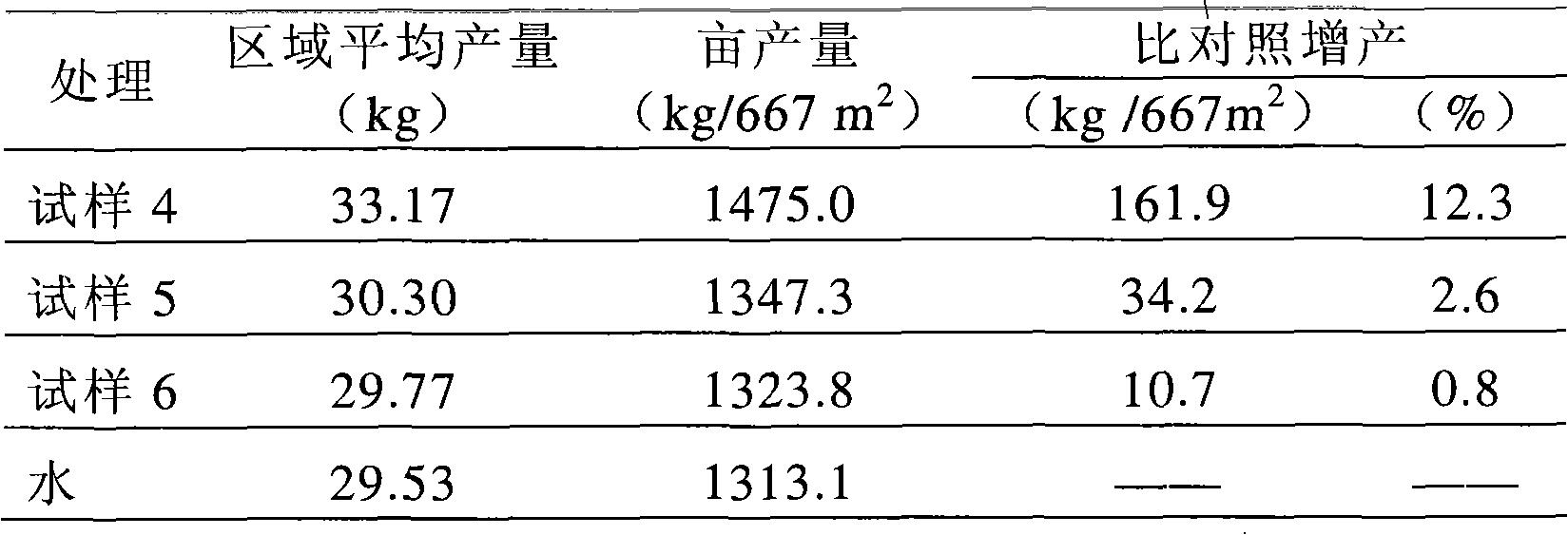Titanium-complex-containing liquid fertilizer, preparation method thereof, and solid fertilizer containing the same
A technology of liquid fertilizers and titanium complexes, applied in fertilizer mixtures, fertilization devices, agriculture, etc., can solve the problems of high cost and failure to overcome the product stability period, and achieve the effect of reduced dosage and high stability
- Summary
- Abstract
- Description
- Claims
- Application Information
AI Technical Summary
Problems solved by technology
Method used
Image
Examples
Embodiment 1
[0044]Dissolve 24 kg of titanium sulfate in 300 kg of water at 60° C., add 28 kg of lactic acid, and stir for 1 hour at 60° C. with a rotational speed of 60 rpm. Then add 38 kg of tartaric acid, and stir for 1 hour at 50° C. and a rotating speed of 60 rpm. Aged at 60° C. for 2 days. (The total number of moles of lactic acid+tartaric acid): The number of moles of Ti(IV) was 5.64. Filter, and the filtrate is diluted with water to titanium ion concentration and be 1 mass % (the mensuration of titanium ion concentration can be carried out according to the method described in the following document: " graphite furnace atomic absorption spectrometry determines trace titanium in metallurgical material ", " analysis test Chamber", Vol.5, No.11, pp. 16-18, Zheng Yi, etc.), thus preparing sample 1.
[0045] Dissolve 24 kg of titanium sulfate in 300 kg of water at 60° C., add 28 kg of lactic acid, and stir for 1 hour at 60° C. with a rotational speed of 60 rpm. Aged at 60° C. for 2 da...
Embodiment 2
[0050] Add 80 grams of Vc (ascorbic acid) into 300 ml of water at 30°C and stir until dissolved. Then add 6 g of TiCl to the Vc aqueous solution 4 , and stirred for 3 hours under the condition that the rotation speed was 100rmp. Filtrate, collect the filtrate, the filtrate is a brown solution, so as to obtain the Ti-Vc complex as a comparative sample.
[0051] Sample 1 was prepared in the same manner as in Example 1. Water was added to Sample 1 and Comparative Sample respectively to dilute so that the titanium ion concentration was 0.3% by mass, and the pH was adjusted to 4 with acid. Then, the treated sample 1 and the comparative sample were sealed and stored at room temperature in a light-proof environment, and the time for precipitation to appear was observed. Sample 1 remained clear and transparent after one year. After testing, the concentration of titanium ions was almost unchanged at 0.29% by mass. A large amount of black precipitates appeared in the comparative sa...
Embodiment 3
[0054] Dissolve 24 kg of titanium sulfate in 300 kg of water at 60° C., add 28 kg of lactic acid, and stir for 1 hour at 60° C. with a rotational speed of 100 rpm. Then add 38 kg of tartaric acid, and stir for 1 hour at 50° C. and a rotating speed of 100 rpm. Aged at 60° C. for 2 days. (The total number of moles of lactic acid+tartaric acid): The number of moles of Ti(IV) was 5.64. Filtrate, dilute the filtrate with water to a titanium ion concentration of 30ppm (sample 4), 15ppm (sample 5), 10ppm (sample 6), and then carry out field experiments.
[0055] Test crop: Thai bamboo leaf spinach, its seeds were purchased from Fujian Yongan Seed Company
[0056] Soil for the test: In August 2009, it was carried out in Maoping Village, Yannan Street, Yongan City, Fujian Province. The test site was a sandy mud field with a pH value of 4.6. The main components of the soil were as follows: organic matter 16.7g / kg, alkali Nitrogen solution 109mg / kg, available phosphorus 209.2mg / kg, av...
PUM
 Login to View More
Login to View More Abstract
Description
Claims
Application Information
 Login to View More
Login to View More - R&D
- Intellectual Property
- Life Sciences
- Materials
- Tech Scout
- Unparalleled Data Quality
- Higher Quality Content
- 60% Fewer Hallucinations
Browse by: Latest US Patents, China's latest patents, Technical Efficacy Thesaurus, Application Domain, Technology Topic, Popular Technical Reports.
© 2025 PatSnap. All rights reserved.Legal|Privacy policy|Modern Slavery Act Transparency Statement|Sitemap|About US| Contact US: help@patsnap.com


